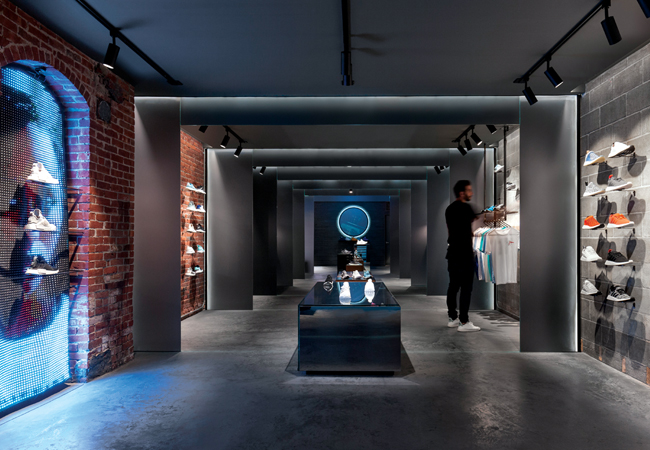
The quasi-temple feel of a recently opened Sanctuary store in Boston, Massachusetts, devoted to Adidas and designed by Montreal-based SLA
The retail sector is in a state of flux. The high street is hollowed out, traditional supermarket behemoths are looking less invincible under the assault of cost-slashing competitors.
A key factor, of course, is shifting consumer buying patterns, with online shopping offering convenient and irresistible options for the customer. An upshot of these disruptive developments has been the growing emphasis on ‘retailtainment’.
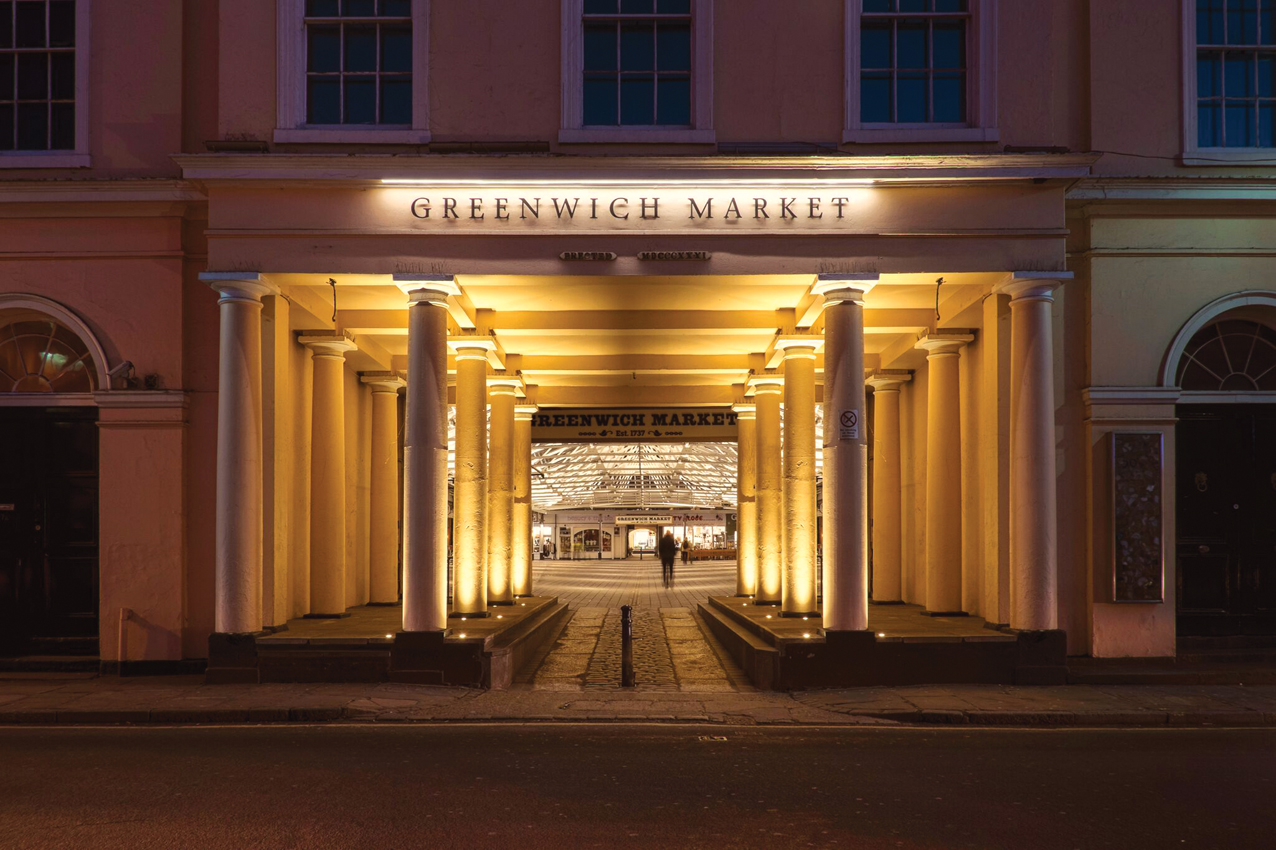
An example of signage illumination at London’s Greenwich Market, with lighting by Hoare Lea
The retail experience must offer what the online process cannot – a tactile, sensory, stimulating and three-dimensional encounter. This has repercussions for design, which is crucial to creating an appealing ambience. Lighting, one of the key components in conjuring up atmosphere and delineating the merchandise, is now even more vital for setting the scene and providing dynamism.
Retail interiors have moved way beyond a bit of spotlighting from a ceiling track. As elsewhere, LEDs have opened up the creative gates at just the right moment, allowing a multiplicity of techniques – from discreet, integrated shelf lighting through to increasingly prevalent giant video walls.
Given the growing complexities in this sector, it is a timely moment for the Society of Light and Lighting (SLL) to introduce its first lighting guide in this area – LG17 Lighting for Retail Premises.
It has taken three years to put together, and the society recognises that it fills an important gap in its guidance documents.
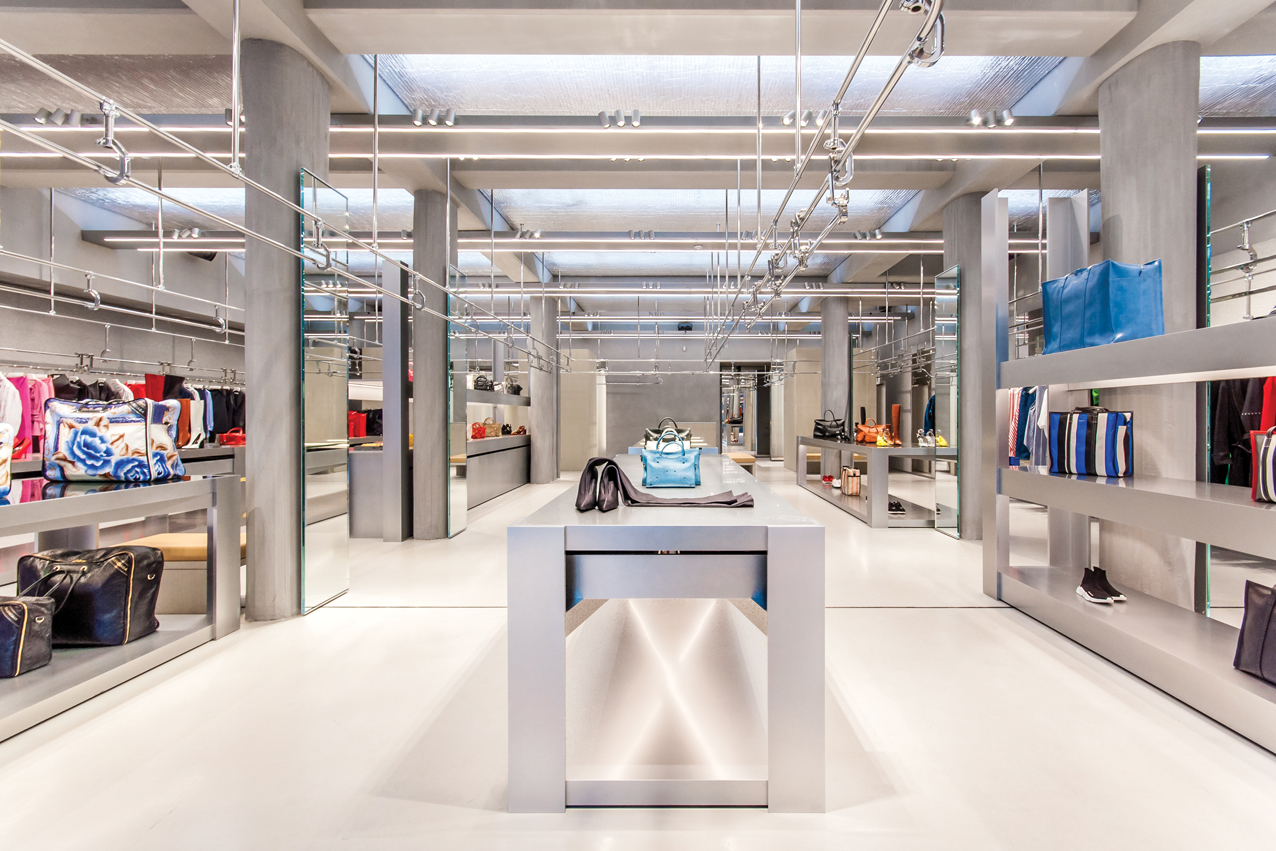
Licht Kunst Licht’s scheme for the Balenciaga flagship store in Paris reflects an industrial aesthetic
‘We wanted to help designers who have little or no experience with retail lighting, and to provide an insight – for shop owners, architects and interior designers – into what a lighting designer will need to consider during the design process,’ says lead author Simon Robinson, of WSP. ‘The guide is not aimed at those who are either experienced retail designers or owners/managers of large retail chains with easy access to those skills.’
As authors of guidance publications are only too aware, readers cherry pick the sections relevant to their situation, rather than the whole document. To help this type of reader, LG17 opens with a chapter on the approach to designing retail lighting.
‘This sets the scene and covers topics that are expanded on later in the guide,’ says Robinson, who is chair of the SLL technical and publications committee. ‘It can be thought of as a foundation for the book and includes useful tips on issues, such as making sure you have the right information about how the owner intends to operate the shop before the design process starts.’
Questions example
Pre-design stage questions to ask the client:
- Is daylight to be optimised or excluded?
- What tasks are to be performed by staff?
- Will staff be located in set positions or mobile?
- How critical is good colour representation of merchandise?
- Will merchandise have small text that needs to be read by customers?
- How important is the vertical surface? It is key in a bookstore, for example, but perhaps not so much in a bakery.
A suggested list of questions (see panel, ‘Questions example’, above) will help inform the whole design process and may lead the reader to consider something that had not occurred to them before, says Robinson.
‘The creative elements of a design will need to draw heavily on the intended use of the retail space and the owners’ aspirations for their business. Trends in shopping habits and interior design can be strong influences and lead to customers expecting a particular “look” to a space, even though the shop owner may prefer something else.
‘A good example is the trend in fashion stores towards high contrast lighting, which uses display lighting almost exclusively,’ adds Robinson. ‘The popularity of this approach with customers means an expectation develops, and similar shops may need to follow the design ideas, even if the shop owner is not a fan of the “look”.’
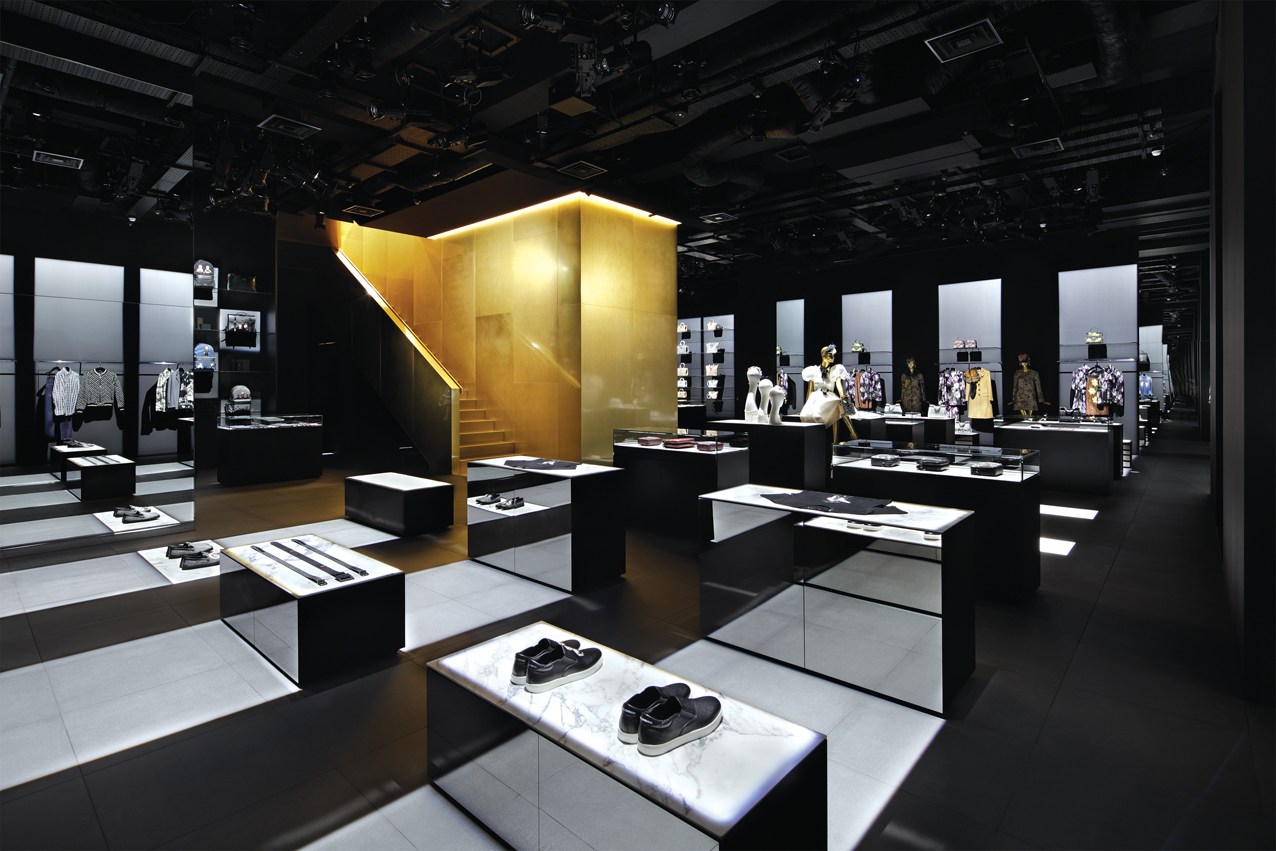
The flagship Dolce & Gabbana in Aoyama, Tokyo, with interior lighting by Curiosity, is designed around the themes of light and shadow
Displaying the merchandise to best advantage is an important focus, but – as with all SLL guides – the approach is more holistic, considering the store, shop or supermarket as a workplace, as well as somewhere that sells things.
‘Retail spaces are places of work for millions of people around the world and their occupational health and safety have been addressed in the new guide,’ says Robinson. ‘Traditionally, the sales or checkout positions, as well as back-of-house locations, have been easily identified as areas where staff will spend time, making it relatively easy to provide appropriate lighting for their tasks.’
The use of smart devices, however, has complicated matters. ‘Increasingly common is the flexible approach that tablets and other touchscreen devices have brought to retail,’ says Robinson. ‘Staff can now spend long periods of time with customers in any part of the space, making it more difficult to provide a lighting design that addresses their needs.’
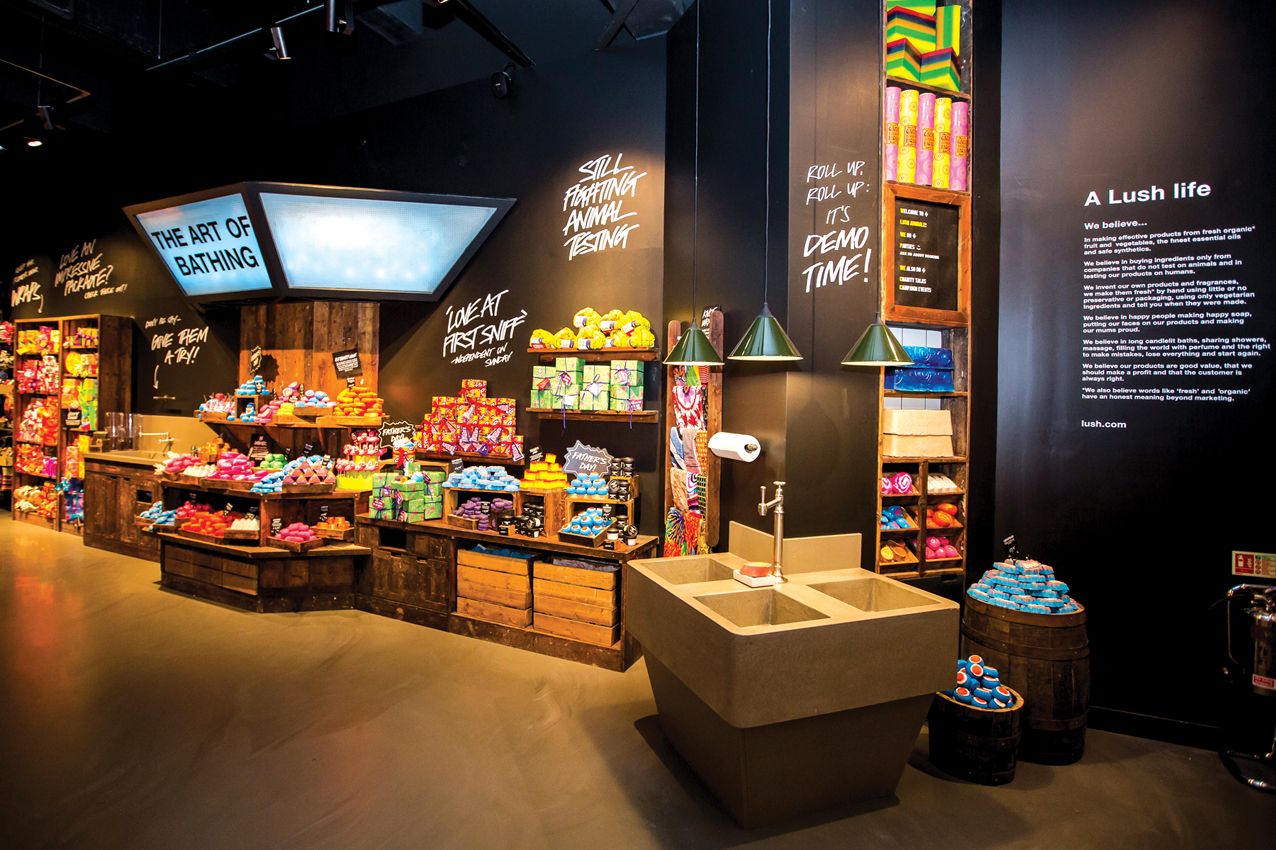
Lush lighting design by Michael Grubb Studio, with a characteristically high-contrast interior
The guide recognises that energy reduction is a fundamental part of any design project – though retail lighting, like other leisure areas, has always been recognised as having rather different needs than, say, an office environment.
‘There will always need to be a balance between appropriate use of energy, the use of lighting to highlight merchandise or sales banners, and the need to offer an inviting environment for customers,’ says Robinson. ‘Hopefully, LG17 addresses these issues while recognising the need to allow designers to be creative in the use of lighting in retail spaces.’
LG7, on office lighting, was the first lighting guide to introduce examples of how various spaces could be illuminated. This approach has been carried through to the retail guide, which includes 10 examples of retail spaces, ranging from a small to medium-sized, general-purpose retail space to a fully glazed car showroom.
Robinson draws an analogy with office spaces, in that retail tends to be associated with large shopping complexes, supermarkets or department stores. In reality, however, the vast majority of retail outlets are small, general-use spaces, often repurposed or occupying space not suitable for any other use – which is why the practical examples begin with a general-purpose shop.
SLL guides update
SLL Lighting Handbook (2018)
The new handbook has just been published. All existing chapters have been updated and an additional 13 have been included – along with four appendices – making the 2018 version one of the most comprehensive guides to interior and exterior lighting in the world.
LG1: The Industrial Environment (updated 2018)
Updated by addenda after a review in October 2018.
LG13: Lighting for Places of Worship (updated 2018)
Also reviewed in October 2018 and now featuring an addendum.
LG17: Lighting for Retail Premises (2018)
The SLL’s first guide to lighting for retail premises was published in October.
LG18: Lighting for Licensed Premises (2018)
With a slight change of title, this publication has been updated and expanded for its second edition.
‘Such spaces make up the majority of retail establishments, so the uses to which they can be put is extensive and the example discusses two approaches,’ says Robinson.
‘The first acknowledges that many shop owners simply want a flexible, general-purpose space that can maximise their opportunity to sell merchandise. The second considers the use of display lighting for sales promotions, or to highlight particular parts of the space or merchandise on sale.’
Internet-based retail is also considered in LG17, with an example examining the lighting approach for a collection point in a store front.
For many segments of the retail sector, there is no doubt that business now is literally a hard sell. However, as LG17 affirms, good design – specifically good lighting design – is critical in differentiating the real shopping experience from the sedentary and sterile online transaction.
- LG17 Lighting for Retail Premises is available through the CIBSE Knowledge Portal. Members of the SLL receive unlimited online access to all SLL publications. For information about becoming a member, email sll@cibse.org
